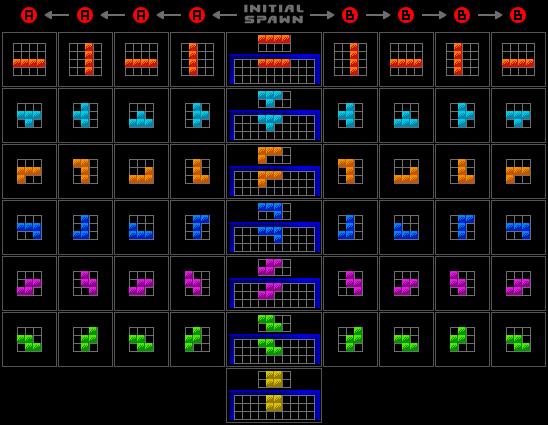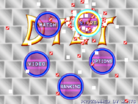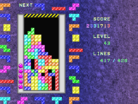DTET
| DTET | |
|---|---|
| Developer(s) | Mihys |
| Publisher(s) | N/A |
| Platform(s) | Microsoft Windows (tested to run on XP, but not Vista) |
| Release | February? 2003 (First release) |
| Latest release | 1.00 (2004-09-06) |
| Gameplay info | |
| Next pieces | 0-3, 25 |
| Hold piece | No |
| Hard drop | Usable in HARD, ADVANCE, and FINAL levels |
| Rotation system | DTET Rotation System |
DTET was a fan game created in Japan with the goal to create the author's own vision of Tetris, different from both the guidelines or TGM.
Controls and rotation system
The game's control system consists of 2 rotate buttons, unlike many other Japanese games which feature a duplicate button for one of the directions (usually counter-clockwise). However, when a piece is rotated, and the other rotate button is presssed while the first button is still being pressed, the piece rotates an extra turn in the direction of the first button, for an overall 180 degree rotation, otherwise known as a "double rotation". One can also produce an instant double rotation (treated as counterclockwise for wallkick testing purposes) by hitting both buttons simultaneously.
DTET's basic rotations are strongly reminiscent of the ARS and Sega rotation systems, but with two differences:
- S, Z and I pieces have four rotation states instead of two. However, the two horizontal states are identical.
- The horizontal orientation of the I tetromino is shifted 1 cell down.
Pieces spawn horizontally in the center, (left of center for the odd width pieces) with their topmost solid block in row 20. The J, L and T spawn pointing downwards.

While a button is held down, the game will continually attempt to process it, every frame, until it succeeds in producing a rotation. Once a pressed button has produced a rotation, it must be released before it can produce any further rotations. Therefore, if a rotation fails due to an obstacle, but the rotate button is held down while the piece is moved away from the obstacle, the rotation will occur on the first frame on which it is possible. This has been called "failure compensation". Also, if a rotation is attempted during ARE and the rotate button held down until spawn, the rotation will occur on the first frame after spawn, if it is possible to do so, thereby creating an IRS-like rotation.
Wall kicks
The wall kicks in DTET are an extension of the system pioneered by Arika in TGM's rotation system. In addition to testing for wall kicks 1 cell to the left and right, DTET will also continue to test for wall kicks 1 cell down, followed by 1 cell diagonally down-left and down-right. DTET's wall kicks are sometimes described as "symmetric", the reason being that kicks left and down-left take precedence when rotating with the right rotation button, and kicks right and down-right take precedence when rotating with the right button.
| "Left rotation button" | "Right rotation button" | |
|---|---|---|
| 1 | one space left | one space right |
| 2 | one space right | one space left |
| 3 | one space down | one space down |
| 4 | one space down-left | one space down-right |
| 5 | one space down-right | one space down-left |
It's very important to note that the kick priority is bound to which button you press, and not bound to the actual rotation. This means that, if one were to hold B for one right rotation and then pressed A for a second right rotation, this second rotation would prioritize kicks to the left. This also works in the opposite direction, where holding A and then pressing B would result in a second left rotation with a kick bias to the right, because button B was pressed.
Additionally, the rotation system does not employ the kick restrictions in ARS. As long as a piece is able to pass one of the kick tests, it will kick and rotate, regardless of whether or not the adjacent blocks are occupied.
RUSH System
DTET features a toggle for what's called the RUSH system. If RUSH is enabled, the game calculates several piece behaviors, including gravity and automatic piece shifting, 20 times per frame instead of just once.
This has some interesting effects, such as the piece instantly moving to the left or to the right as far as possible if DAS is charged, or the piece looking like it instantly lands on the floor - by technicality, it doesn't, because it cycles through the individual calculations and update order (Movement, rotations, gravity) 20 times per frame, which means gravity gets applied 20 times in one frame and piece movement logic gets applied 20 times in one frame. This means that, in theory, if you were to play at 1G gravity (such as Time Attack's NORMAL difficulty) with RUSH enabled, you can do everything the piece could do at 1G - it just happens 20 times in one frame. This means if the stack is low enough or shaped properly, you can instantly move pieces to the left or right walls in that game mode.
Game modes
DTET features score attack, time attack and battle modes, as well as two special ("FINAL") modes.
Score attack is a mode where getting a certain number of lines (usually 8, sometimes more in HARD mode) increases the level, and the objective it to survive as long as possible and get the highest score possible. The player has five lives in this mode, and should the player block out, they will lose one life and keep going until they run out of lives.
Time attack is a mode where the player must clear 100 lines at the maximum level for each mode, with three lives. Clearing all the required lines without losing a life will give the player a Perfect.
Battle modes are where the player faces off against other players (over LAN) or against CPU opponents. In the Official Battle menu, the player can choose the AI strength and game difficulty (mode and level).
FINAL modes are expert-only modes. Joker starts at level 50 with the highest gravity where each line clear increments the level counter. Quadruples add one to the stock. The "stock" counter determines how many non-quadruple line clears they can perform in level 200 and beyond. At level 200, quadruples will only count toward the current level, and any other line clear decreases the player's stock by 1. Once the player's stock reaches 0, the game ends. If they manage to playing until level 300 with at least 1 stock, they can continue on as long as they have stocks. Players only have one life in this mode. Furthest is a hard 20G challenge where players have 10 lives to clear 300 lines. All of the delays in this mode are incredibly short. Both of these modes blend the pieces in with the background, only showing an outline of the stack.
There are three different modes which can be applied to the score attack, time attack, and battle modes. In each, there is a drop in gravity at level 20 as well as level 40 (except in NORMAL, where the game never reaches 40). Levels 50 and up are 20G.
NORMAL mode caps off at level 30. The hard drop option is unusable in this mode.
HARD mode caps off at level 50. In score attack, the number of lines per level steadily grows over the course of the game. Level 50 requires 500 lines.
ADVANCE mode has a time limit located at the bottom of the playfield, and caps off at level 200. Line clears will restore the timer, and if time runs out, the game will end instantly, regardless of the number of lives the player has. In score attack, each level past 50 is earned with one line clear.
See also
Links
- New official DTET Website (note: game is no longer available for download there)
- Download DTET on the Internet Archive

